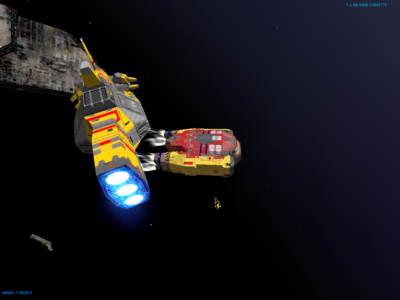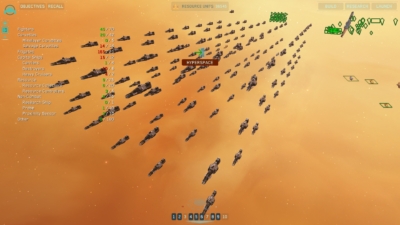For the first article in this series I wrote about Relic’s realtime strategy classic Homeworld, and I’m returning to it today.
As you might expect for this sort of game, Homeworld lets you build warships of varying size and potency. You start out with small, speedy fighters and corvettes. A few missions later you’re granted access to Frigates, which file the role of mid-sized gunboat. Further along, the real heavyweights become available, destroyers and cruisers bristling with enormous cannons and lasers.
One of the most useful ships in your fleet, however, is totally unarmed and has a far more devious use. The salvage corvette’s job is to capture enemy ships. When given a target, the salvagers will clamp onto it and try to forcibly drag it back to the mothership. The larger the vessel, the more salvagers you need to grab it. If they are destroyed, the target will break free. If however they successfully bring the ship home, it is added to your fleet.
First, however, you must take steps to ensure that the salvagers survive. They’re slow and fragile, and won’t last long if they come under attack. Usually the best tactic is to keep the enemy distracted. Before you try and capture some ships, send in disposable scout fighters to harass them first. The enemy AI can be rather single minded, focussing entirely on destroying the first ship that it sees. So your targets should, hopefully, keep firing on your scouts and ignore the incoming salvagers.

Trying to grab a frigate.
The immediate benefit of capturing ships instead of destroying them is obvious enough – not only does the enemy have one less ship, but you have one more. Even if a few salvagers are lost, their sacrifice is worthwhile it if you claimed a something valuable like a destroyer in the process. If you actually don’t even need the ship for whatever reason, it can be scrapped for resources to build something you prefer.
There are a few more perks – you can gain some types of vessel before your Mothership can build them, by stealing them from the enemy. You can even get a mighty heavy cruiser a mission or two early. It’s also the only way to obtain some ships that you can’t build at all, like the ridiculously over-gunned Kadeshi frigates.
The most important reason to use salvagers though, is simply to maximise the size of your fleet. Even if you’re overflowing with resources, there’s a hard cap on how many ships you can build. However, the game imposes no limits on the number of ships you can capture. Everything you see can in theory be added to your fleet, if the salvagers can survive their attempt to capture it.
If you at all appreciate the value of this humble, utilitarian little corvette, you will see chances to use it in every battle. You learn to quickly scan any presented enemy and think, what can I capture here, and what’s too going to be too much trouble?
So then fighters aren’t worth the effort, they’re too fast to capture and cheap to build anyway. Frigates are often a worthwhile target though. If a block of half a dozen come along, there’s no reason to not grab at least a couple. Your top priority is any heavy warship that is alone or only lightly escorted. Its heavy weapons will serve you well.
If you find yourself in pitched battle with a large fleet of multiple ship types, it’s not realistically possible to capture everything that you’re facing. So your objective should be, isolating the targets of greatest value. Divide the enemy, keep them distracted, destroy their less important ships. Then it should be safe to send in the salvagers.
Many players at least become opportunistic salvagers, grabbing a few spare ships in each engagement. Some will adjust tactics to maximise salvaging, seeking to take as many warships as possible in each battle. Since your fleet is persistent from one level to the next, it can steadily expand with ranks of captured ships. In time, it becomes a patchwork armada. Some ships you built yourself of course, but half or more are in the yellow and black of the Taidani, your primary enemy. Lurking around the edges are random oddities taken from third parties, thrown in for good measure.
This honestly suits the theme of the game quite well. You’re meant to be a commanding bunch of desperate exiles, who have been scrambling to assemble a fleet around the lone mothership, which is all that remains of their civilisation. They’re trying to challenge a far stronger empire to claim their Homeworld. It makes sense that they would capture enemy assets, wherever possible, to supplement their own limited forces.
The most memorable use of salvaging, and the time I really used this feature excess, was at the Bride of Sighs. This is one of the last campaign missions, where the objective is to destroy a fixed installation. It’s guarded by a huge spherical formation of about a hundred and fifty Ion frigates, capital-ship killers each armed with single powerful beam weapon.
A few dozen of them firing at once could have crippled even a mighty cruiser. I suppose you’re meant to feint, draw portions of the sphere away and bring overwhelming force to bear on a few of them at a time. Instead, a little sign popped up in my head: STEAL THEM ALL
ALL OF THEM
The setup was quite condusive to salvaging. The frigates were all widely spaced, that coming close to any one of them only put my ships within firing range of a couple others. I could easily dangle some distraction ships in front of a few, lure them out and send in the salvagers. Others tended to pursue, but, after a while would give up and return to formation in the big sphere.
Even though the mission seemed like salvage heaven, I proceeded slowly and cautiously. Each time I sent the salvagers out I grabbed just a couple of frigates. I didn’t want to have to micromanage too many operations at once, also I feared enraging the entire sphere. The whole process took many hours, spread across two or three evenings. A more skilful and bolder player could probably have worked faster by grabbing six or eight frigates at a time.
Steadily I added ion frigates to my fleet. More and more parked next to the Mothership. After about thirty ships you’d think I’d had enough but nope, I kept going. More ion beams for the fleet, more ships to join our quest to reclaim the Homeworld. Another few dozen piled up. They formed a huge grid in space, a massive formation of silent sentinels awaiting orders. More frigates. MOAR.
In the end I didn’t literally take them all. Once they grab a ship, salvage corvettes take a straight line home and cannot be redirected. Therefore anything on the far side of the sphere would have come too close to the central base, and triggered an angry response. Still I must have taken over a hundred.
Eventually I destroyed the base and completed the actual mission objective, which by now was almost an afterthought. I had so many frigates that I broke the “line up for hyperspace” script that concludes a mission. At this point your fleet is meant to form up in neat rows, but the line of frigates was actually too long to fit on the level map. They just milled around in confusion.

An example megafleet. Image credit Corew1n on reddit because I never have the screenshots I want for these articles, dammit.
The next two missions are the final ones in the campaign. Here at last it’s time to put the salvagers to rest, since these are epic, intense battles. Massed ranks of enemies immediately come bearing down on the precious mothership. You need to immediately deploy some heavy firepower and start wrecking those Taidani warships. Obviously these missions are meant to be extremely challenging, a fitting finale to your struggle for the Homeworld.
With my vast horde, though, I think I nailed both missions in a couple of tries. I believe the game scales enemy fleet size according to your own but even so, it wasn’t coded to account for over a hundred ion frigates.
I didn’t even really bother with manoeuvres or tactics. I just took the massive blob of frigates and either told it to guard the mothership, or just head out into the midst of the enemy formation. I must have lost dozens of frigates along the way. It didn’t particularly matter. They swamped the enemy, got in the way, fired ion beams in random directions, and soaked up cannon shells. Meanwhile my big guns were free to roam around and engage with the targets of my choosing.
That was it! Game completed. Prog rock plays. I had defeated the enemy through a lengthy and tense (and let’s be honest, monotonous) process of thieving, followed by trampling my way through the climax.
Looking back, salvaging was rather overpowered. I’m pretty sure Relic did not expect obsessive gamers like me to exploit it so heavily. In Homeworld 2 the feature was completely nerfed, by making the salvage ships die too quickly to be useful. I’m not surprised that this step was taken.
Still, for many of us, salvaging was a core mechanic of Homeworld, and that massive formation of captured frigates was a glorious sight to behold.



 Posts
Posts